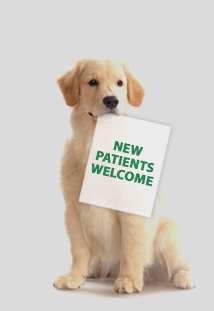
| Monday | 8am - 7pm |
| Tuesday | 8am - 6pm |
| Wednesday | 8am - 6pm |
| Thursday | 8am - 7pm |
| Friday | 8am - 5pm |
| Saturday | By Appointment |
| Sunday | Closed |

With advancements in veterinary medicine and nutrition, pets are living longer than ever before. Like people, as pets age they become more susceptible to illness and disease and need extra attention to help keep them vibrant and healthy. “Exams twice a year are important for older animals... so we have a chance to intervene early should we detect any serious problems,” says Eileen Landry, CVT, of AAHA-accredited Connecticut Veterinary Center & Pet ER.
According to Cindy Morgan, CVT, practice manager of Denver’s AAHA-accredited University Hills Animal Hospital, geriatric patients also need more extensive evaluations than their younger counterparts, such as additional blood tests and ocular pressure checks.
“The tests are age-specific and we customize tests to each animal’s breed and health history. For example, we might do thoracic X-rays on bigger dogs at 7 years, but smaller dogs at 9 years,” explains Morgan.
Symptoms of age-related health problems might be nothing more than subtle behavior changes, so your veterinarian may look to you for additional information.
Something as seemingly insignificant as a change in the way your pet chews or sits can signal a problem. Because you know your pet’s daily patterns and behavior best, sharing your observations with your veterinarian is essential.
According to Morgan, some symptoms creep up so slowly owners do not notice them. She describes a conversation with a client who was picking up a pain reliever for his pet. “He didn’t realize that his dog [was in pain] until after she was on this medication and started being much more active and getting around much more easily.”
Senior Pet Facts,
•
30% have a hidden disease
•
62% of dogs age 10 years and older have symptoms of cognitive dysfunction
•
80% have dental disease
Consider keeping a list of your pet’s behavior changes or physical abnormalities as they occur. Note any changes in coat and skin; gait; posture; oral health, such as bad breath or difficulty eating hard foods; weight; sleep patterns; and hearing or sight.
Questions might include: Does your pet take longer to get up? Is your pet drinking more water? Is your pet sleeping more?
Signs that your pet needs to be seen by a veterinarian immediately include increased water consumption, inability to urinate or excessive or inappropriate urination, staring, and disorientation, to name a few.
Planning for Senior Care
Geriatric examinations usually include a standard physical; eye, ear, mouth, and rectal exams; blood chemistry profile; complete blood count; urinalysis and possibly endocrine (glandular) tests, and X-rays.
These exams may add $200–$400 to your annual veterinary costs, but the expense is much less than what you will ultimately pay if diseases progress untreated. Still, planning for preventive care makes sense.
When will your pet require geriatric care?
Dogs that are small (less than 20 pounds) require geriatric attention when they are 9-13 years old;
Medium, 21–50 pounds, 9–11.5 years old;
Large, 51–90 pounds, 7.5–10.5 years old;
Giant, More than 90 pounds, 6–9 years old;
Cats usually require geriatric care when they are 8–10 years old.